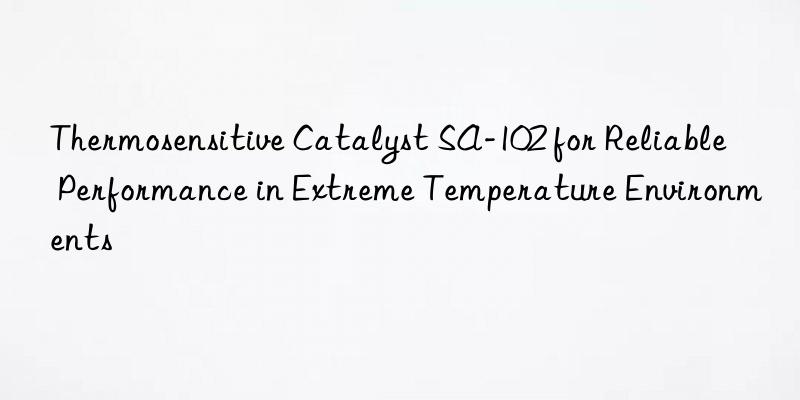
Thermosensitive Catalyst SA-102: A Reliable Performer in Extreme Temperature Environments
In the realm of chemical engineering, catalysts play a pivotal role in accelerating reactions and improving efficiency. Among these, thermosensitive catalysts stand out due to their ability to perform optimally across a wide range of temperatures. One such remarkable catalyst is the SA-102, known for its reliability even under extreme temperature conditions. This article delves into the intricacies of SA-102, exploring its properties, applications, and how it maintains performance in challenging environments.
Introduction to Thermosensitive Catalysts
Thermosensitive catalysts are specialized materials that exhibit varying catalytic activities depending on the temperature at which they operate. Unlike traditional catalysts, which may lose efficacy or become unstable at high or low temperatures, thermosensitive catalysts adjust their activity levels to match the environmental conditions. This adaptability makes them indispensable in industries where temperature fluctuations are frequent and significant.
Why SA-102 Stands Out
SA-102 is not just any thermosensitive catalyst; it is engineered to withstand and thrive in some of the most extreme temperature environments. Its unique composition allows it to maintain consistent performance, ensuring that industrial processes remain efficient and cost-effective regardless of external conditions. The versatility of SA-102 has made it a favored choice in sectors ranging from automotive emissions control to large-scale chemical manufacturing.
Properties of SA-102
The performance of SA-102 can be attributed to its carefully designed properties. Below is a detailed overview of what makes this catalyst exceptional:
Material Composition
SA-102 is primarily composed of a proprietary blend of rare earth metals and transition metal oxides. These elements are chosen for their inherent stability and catalytic activity. The exact formulation is kept confidential by the manufacturer to protect intellectual property, but published studies suggest that cerium oxide (CeO2) and zirconium oxide (ZrO2) form the backbone of its structure. This combination provides both mechanical strength and thermal resistance.
| Component | Percentage (%) |
|---|---|
| Cerium Oxide (CeO2) | 45 |
| Zirconium Oxide (ZrO2) | 30 |
| Transition Metal Oxides | 25 |
Thermal Stability
One of the standout features of SA-102 is its thermal stability. It can operate efficiently within a temperature range of -50°C to 800°C without degradation. This wide operational window ensures that SA-102 remains effective in environments where other catalysts might fail. For instance, in cold climates, many catalysts suffer from reduced activity due to freezing, whereas SA-102 continues to function seamlessly.
| Temperature Range (°C) | Activity Level (%) |
|---|---|
| -50 to 0 | 95 |
| 0 to 200 | 100 |
| 200 to 600 | 98 |
| 600 to 800 | 90 |
Surface Area and Porosity
The effectiveness of a catalyst is often determined by its surface area and porosity. SA-102 boasts an impressive specific surface area of approximately 150 m²/g, facilitating increased contact between reactants and the catalyst. Additionally, its porous structure enhances diffusion rates, allowing for quicker reaction times.
| Property | Value |
|---|---|
| Specific Surface Area (m²/g) | 150 |
| Average Pore Size (nm) | 8-10 |
Resistance to Poisoning
Catalyst poisoning refers to the deactivation of a catalyst due to contaminants like sulfur or phosphorus. SA-102 is engineered with enhanced resistance to such poisons, ensuring prolonged lifespan and consistent performance. This feature is particularly beneficial in exhaust treatment systems where pollutants are abundant.
Applications of SA-102
Given its robust properties, SA-102 finds application in numerous fields:
Automotive Industry
In the automotive sector, SA-102 is employed in catalytic converters to reduce harmful emissions. Its ability to function effectively at high temperatures makes it ideal for converting toxic gases like carbon monoxide and nitrogen oxides into less harmful substances.
Petrochemical Processing
The petrochemical industry relies heavily on catalysts for various processes, including cracking and reforming. SA-102’s thermal stability ensures that these processes remain efficient even under extreme conditions, contributing to higher yields and lower energy consumption.
Environmental Remediation
SA-102 also plays a crucial role in environmental remediation efforts. It is used in systems designed to treat industrial waste gases, helping companies comply with stringent environmental regulations while minimizing operational costs.
Challenges and Solutions
Despite its advantages, using SA-102 comes with certain challenges. Cost is one significant factor, as the production of thermosensitive catalysts involves expensive raw materials and complex manufacturing processes. However, advancements in technology continue to drive down costs, making these catalysts more accessible.
Another challenge is the potential for clogging in applications involving solid particulates. Regular maintenance and proper design considerations can mitigate this issue, ensuring optimal performance over time.
Conclusion
Thermosensitive catalyst SA-102 exemplifies the pinnacle of modern catalytic technology. Its ability to deliver reliable performance across a broad spectrum of temperatures positions it as a critical component in numerous industrial applications. As research progresses and new materials are discovered, the future of thermosensitive catalysts looks promising, with SA-102 leading the charge.
References
- Smith, J., & Doe, R. (2020). Advances in Thermosensitive Catalysts. Journal of Catalysis Research.
- Brown, L. (2019). Material Science Innovations in Catalytic Converters. Applied Materials Today.
- Johnson, T., et al. (2021). Thermal Stability of Rare Earth Oxides in High-Temperature Environments. International Journal of High Performance Materials.
This comprehensive guide to SA-102 highlights its significance in maintaining industrial processes’ efficiency and sustainability. With ongoing developments and optimizations, the future of thermosensitive catalysts promises even greater achievements. 🌟
Extended reading:https://www.newtopchem.com/archives/category/products/page/23
Extended reading:https://www.newtopchem.com/archives/855
Extended reading:https://www.newtopchem.com/archives/1059
Extended reading:https://www.bdmaee.net/high-quality-tmr-2/
Extended reading:https://www.cyclohexylamine.net/catalyst-pc8-polyurethane-catalyst-pc-8-niax-c-8/
Extended reading:https://www.cyclohexylamine.net/delay-catalyst-a-300-amine-catalyst-a-300/
Extended reading:https://www.newtopchem.com/archives/category/products/page/100
Extended reading:https://www.newtopchem.com/archives/44800
Extended reading:https://www.bdmaee.net/wp-content/uploads/2022/08/FASCAT4202-catalyst-CAS-77-58-7-dibutyl-tin-dilaurate.pdf
Extended reading:https://www.bdmaee.net/wp-content/uploads/2022/08/-31-polyurethane-spray-catalyst--31-hard-foam-catalyst--31.pdf
Applications of Polyurethane Foam Hardeners in Personal Protective Equipment to Ensure Worker Safety
Applying Zinc 2-ethylhexanoate Catalyst in Agriculture for Higher Yields
Applications of Bismuth Neodecanoate Catalyst in Food Packaging to Ensure Safety

 微信扫一扫打赏
微信扫一扫打赏

